technical specifications FIAT DUCATO 2011 Owner handbook (in English)
[x] Cancel search | Manufacturer: FIAT, Model Year: 2011, Model line: DUCATO, Model: FIAT DUCATO 2011Pages: 287, PDF Size: 4.42 MB
Page 137 of 287

133
KNOWING
YOUR CAR
SAFETY
STARTING
AND
DRIVING
WARNING
LIGHTS AND
MESSAGES
IN AN
EMERGENCY
MAINTENANCE
AND CARE
TECHNICAL
SPECIFICATIONS
INDEX
SUITABILITY OF PASSENGER SEATS FOR THE USE OF CHILD SEATS
The vehicle complies with the new European Directive 2000/3/EC which governs the arrangement possibilities for
child restraints on the seats of a vehicle as shown in the following table.
Group Weight groups VAN, COMBI and PANORAMA versions
CAB1stand 2ndREAR SEATS ROW
Single seat Passenger Passenger Passenger
or two-seater rear rear central
(1 or 2 passengers) left side right side
Group 0, 0+ up to 13 kg U U U U
Group 1 9–18 kg U U U U
Group 2 15–25 kg U U U U
Group 3 22–36 kg U U U U
Key:
U = suitable for child restraint systems of the “Universal” category, according to European Standard EEC-R44 for the specified
“Groups”.
Page 138 of 287
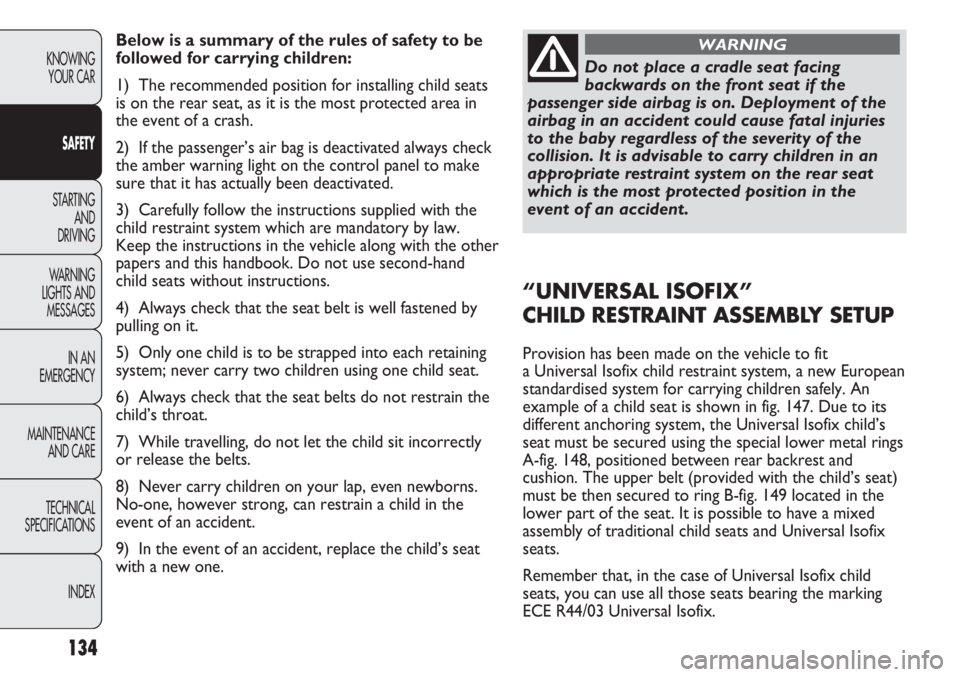
134
KNOWING
YOUR CAR
SAFETY
STARTING
AND
DRIVING
WARNING
LIGHTS AND
MESSAGES
IN AN
EMERGENCY
MAINTENANCE
AND CARE
TECHNICAL
SPECIFICATIONS
INDEX
Below is a summary of the rules of safety to be
followed for carrying children:
1) The recommended position for installing child seats
is on the rear seat, as it is the most protected area in
the event of a crash.
2) If the passenger’s air bag is deactivated always check
the amber warning light on the control panel to make
sure that it has actually been deactivated.
3) Carefully follow the instructions supplied with the
child restraint system which are mandatory by law.
Keep the instructions in the vehicle along with the other
papers and this handbook. Do not use second-hand
child seats without instructions.
4) Always check that the seat belt is well fastened by
pulling on it.
5) Only one child is to be strapped into each retaining
system; never carry two children using one child seat.
6) Always check that the seat belts do not restrain the
child’s throat.
7) While travelling, do not let the child sit incorrectly
or release the belts.
8) Never carry children on your lap, even newborns.
No-one, however strong, can restrain a child in the
event of an accident.
9) In the event of an accident, replace the child’s seat
with a new one.
Do not place a cradle seat facing
backwards on the front seat if the
passenger side airbag is on. Deployment of the
airbag in an accident could cause fatal injuries
to the baby regardless of the severity of the
collision. It is advisable to carry children in an
appropriate restraint system on the rear seat
which is the most protected position in the
event of an accident.
WARNING
“UNIVERSAL ISOFIX”
CHILD RESTRAINT ASSEMBLY SETUP
Provision has been made on the vehicle to fit
a Universal Isofix child restraint system, a new European
standardised system for carrying children safely. An
example of a child seat is shown in fig. 147. Due to its
different anchoring system, the Universal Isofix child’s
seat must be secured using the special lower metal rings
A-fig. 148, positioned between rear backrest and
cushion. The upper belt (provided with the child’s seat)
must be then secured to ring B-fig. 149 located in the
lower part of the seat. It is possible to have a mixed
assembly of traditional child seats and Universal Isofix
seats.
Remember that, in the case of Universal Isofix child
seats, you can use all those seats bearing the marking
ECE R44/03 Universal Isofix.
Page 139 of 287
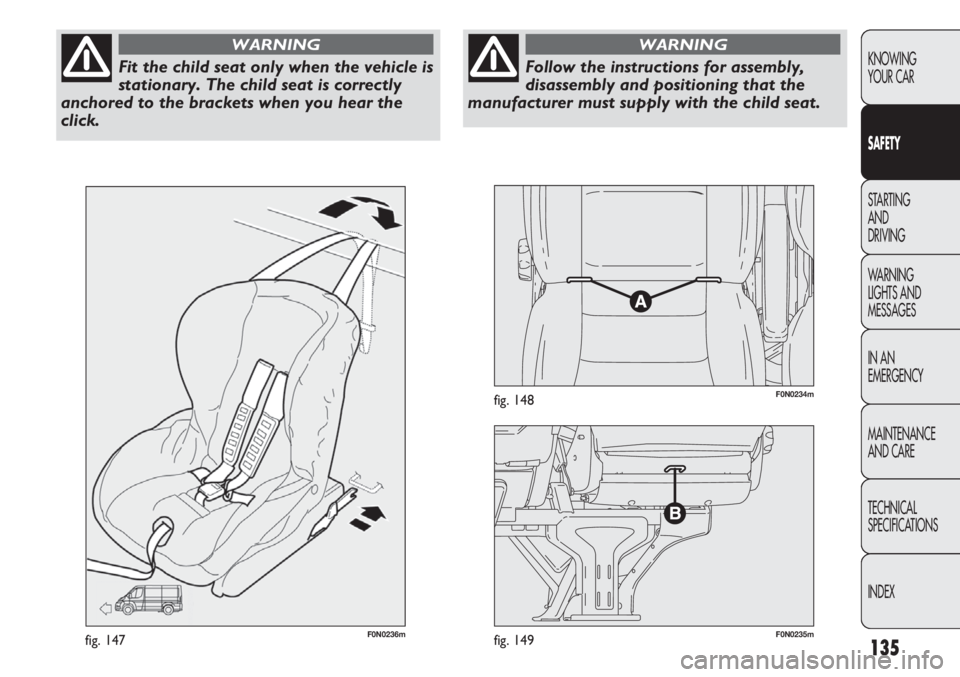
135
KNOWING
YOUR CAR
SAFETY
STARTING
AND
DRIVING
WARNING
LIGHTS AND
MESSAGES
IN AN
EMERGENCY
MAINTENANCE
AND CARE
TECHNICAL
SPECIFICATIONS
INDEX
F0N0236mfig. 147F0N0235mfig. 149
F0N0234mfig. 148
Fit the child seat only when the vehicle is
stationary. The child seat is correctly
anchored to the brackets when you hear the
click.
WARNING
Follow the instructions for assembly,
disassembly and positioning that the
manufacturer must supply with the child seat.
WARNING
Page 140 of 287
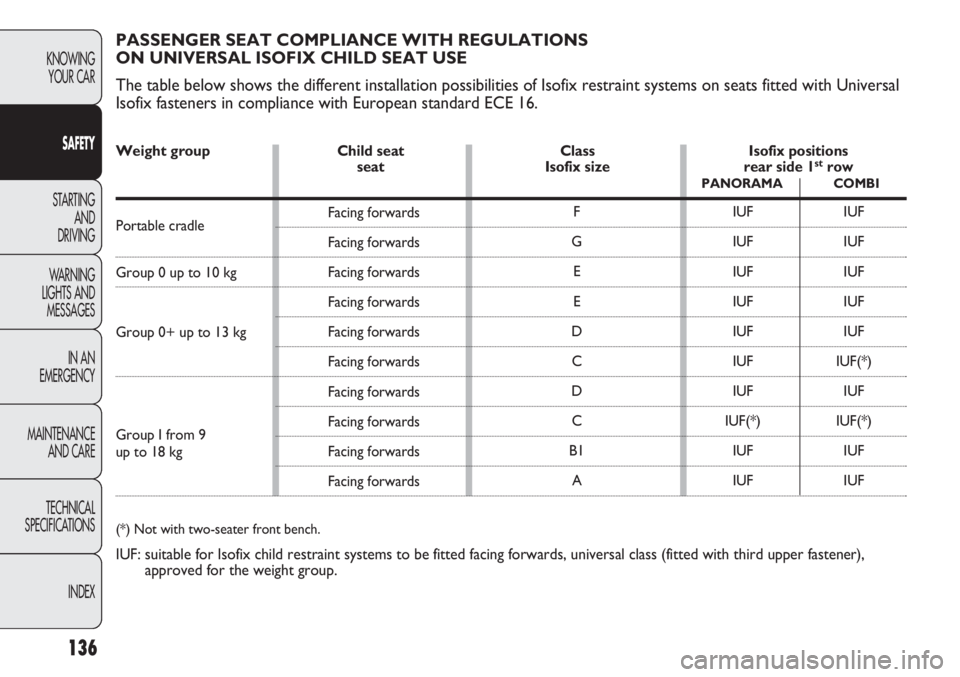
136
KNOWING
YOUR CAR
SAFETY
STARTING
AND
DRIVING
WARNING
LIGHTS AND
MESSAGES
IN AN
EMERGENCY
MAINTENANCE
AND CARE
TECHNICAL
SPECIFICATIONS
INDEX
PASSENGER SEAT COMPLIANCE WITH REGULATIONS
ON UNIVERSAL ISOFIX CHILD SEAT USE
The table below shows the different installation possibilities of Isofix restraint systems on seats fitted with Universal
Isofix fasteners in compliance with European standard ECE 16.
Weight group Child seat Class Isofix positions
seat Isofix size rear side 1strowPANORAMA COMBI
Portable cradle
Group 0 up to 10 kg
Group 0+ up to 13 kg
Group I from 9
up to 18 kg
Facing forwards
Facing forwards
Facing forwards
Facing forwards
Facing forwards
Facing forwards
Facing forwards
Facing forwards
Facing forwards
Facing forwardsF
G
E
E
D
C
D
C
B1
AIUF
IUF
IUF
IUF
IUF
IUF
IUF
IUF(*)
IUF
IUFIUF
IUF
IUF
IUF
IUF
IUF(*)
IUF
IUF(*)
IUF
IUF
(*) Not with two-seater front bench.
IUF: suitable for Isofix child restraint systems to be fitted facing forwards, universal class (fitted with third upper fastener),
approved for the weight group.
Page 141 of 287
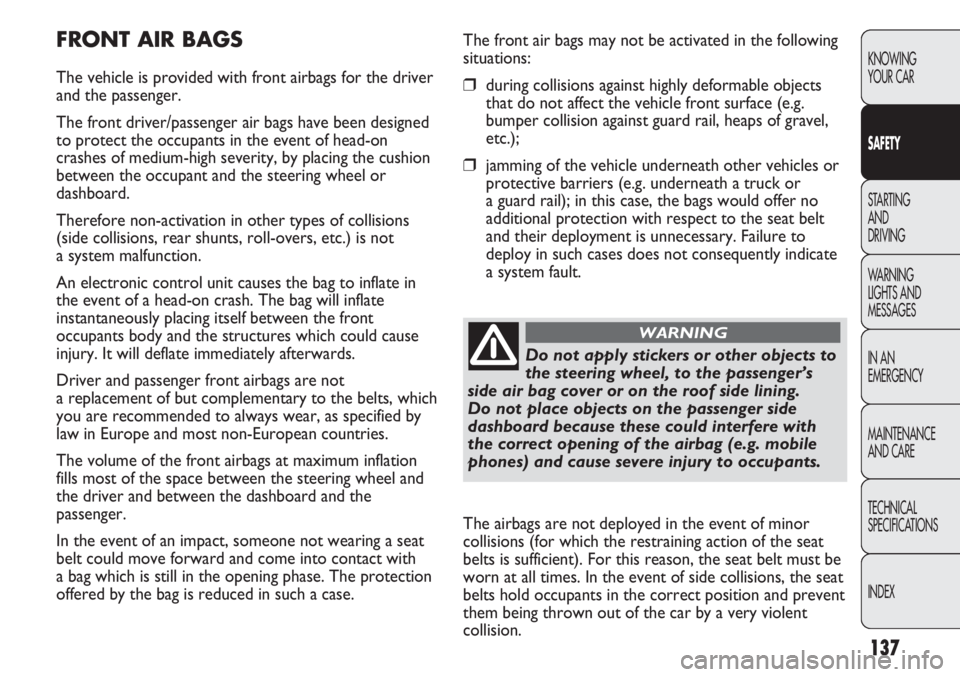
137
KNOWING
YOUR CAR
SAFETY
STARTING
AND
DRIVING
WARNING
LIGHTS AND
MESSAGES
IN AN
EMERGENCY
MAINTENANCE
AND CARE
TECHNICAL
SPECIFICATIONS
INDEX
The front air bags may not be activated in the following
situations:
❒during collisions against highly deformable objects
that do not affect the vehicle front surface (e.g.
bumper collision against guard rail, heaps of gravel,
etc.);
❒jamming of the vehicle underneath other vehicles or
protective barriers (e.g. underneath a truck or
a guard rail); in this case, the bags would offer no
additional protection with respect to the seat belt
and their deployment is unnecessary. Failure to
deploy in such cases does not consequently indicate
a system fault.
FRONT AIR BAGS
The vehicle is provided with front airbags for the driver
and the passenger.
The front driver/passenger air bags have been designed
to protect the occupants in the event of head-on
crashes of medium-high severity, by placing the cushion
between the occupant and the steering wheel or
dashboard.
Therefore non-activation in other types of collisions
(side collisions, rear shunts, roll-overs, etc.) is not
a system malfunction.
An electronic control unit causes the bag to inflate in
the event of a head-on crash. The bag will inflate
instantaneously placing itself between the front
occupants body and the structures which could cause
injury. It will deflate immediately afterwards.
Driver and passenger front airbags are not
a replacement of but complementary to the belts, which
you are recommended to always wear, as specified by
law in Europe and most non-European countries.
The volume of the front airbags at maximum inflation
fills most of the space between the steering wheel and
the driver and between the dashboard and the
passenger.
In the event of an impact, someone not wearing a seat
belt could move forward and come into contact with
a bag which is still in the opening phase. The protection
offered by the bag is reduced in such a case.
Do not apply stickers or other objects to
the steering wheel, to the passenger’s
side air bag cover or on the roof side lining.
Do not place objects on the passenger side
dashboard because these could interfere with
the correct opening of the airbag (e.g. mobile
phones) and cause severe injury to occupants.
WARNING
The airbags are not deployed in the event of minor
collisions (for which the restraining action of the seat
belts is sufficient). For this reason, the seat belt must be
worn at all times. In the event of side collisions, the seat
belts hold occupants in the correct position and prevent
them being thrown out of the car by a very violent
collision.
Page 142 of 287
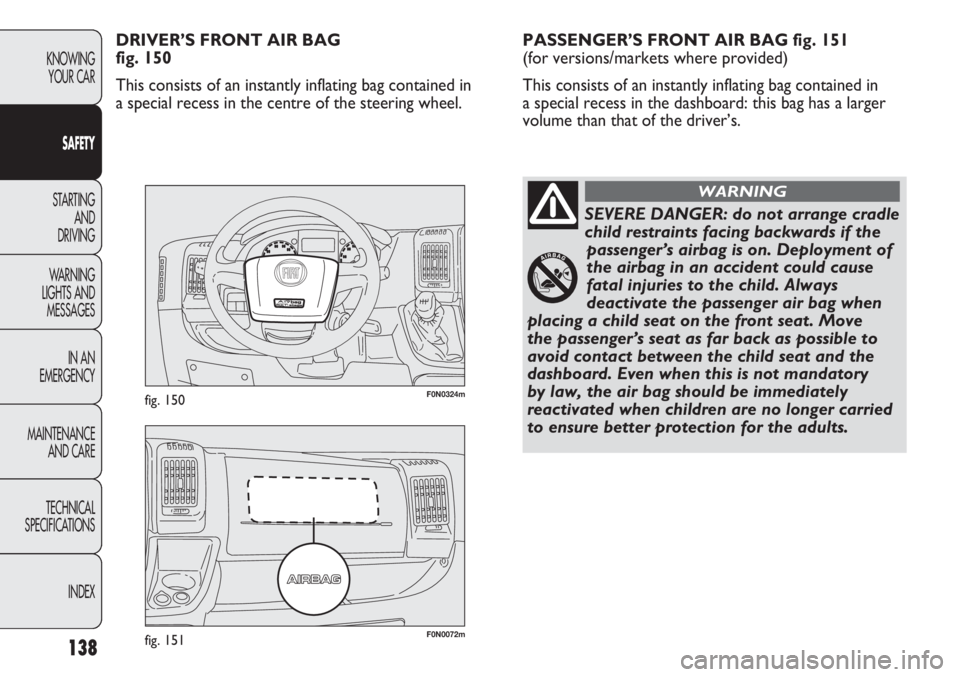
138
KNOWING
YOUR CAR
SAFETY
STARTING
AND
DRIVING
WARNING
LIGHTS AND
MESSAGES
IN AN
EMERGENCY
MAINTENANCE
AND CARE
TECHNICAL
SPECIFICATIONS
INDEX
F0N0072mfig. 151
F0N0324mfig. 150
PASSENGER’S FRONT AIR BAG fig. 151
(for versions/markets where provided)
This consists of an instantly inflating bag contained in
a special recess in the dashboard: this bag has a larger
volume than that of the driver’s. DRIVER’S FRONT AIR BAG
fig. 150
This consists of an instantly inflating bag contained in
a special recess in the centre of the steering wheel.
SEVERE DANGER: do not arrange cradle
child restraints facing backwards if the
passenger’s airbag is on. Deployment of
the airbag in an accident could cause
fatal injuries to the child. Always
deactivate the passenger air bag when
placing a child seat on the front seat. Move
the passenger’s seat as far back as possible to
avoid contact between the child seat and the
dashboard. Even when this is not mandatory
by law, the air bag should be immediately
reactivated when children are no longer carried
to ensure better protection for the adults.
WARNING
Page 143 of 287
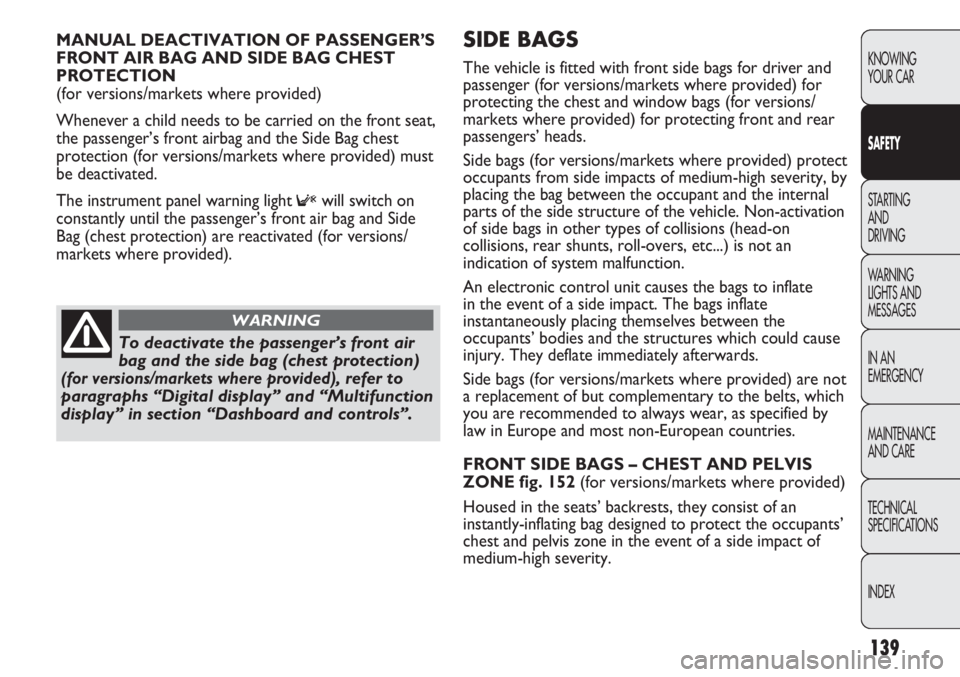
139
KNOWING
YOUR CAR
SAFETY
STARTING
AND
DRIVING
WARNING
LIGHTS AND
MESSAGES
IN AN
EMERGENCY
MAINTENANCE
AND CARE
TECHNICAL
SPECIFICATIONS
INDEX
SIDE BAGS
The vehicle is fitted with front side bags for driver and
passenger (for versions/markets where provided) for
protecting the chest and window bags (for versions/
markets where provided) for protecting front and rear
passengers’ heads.
Side bags (for versions/markets where provided) protect
occupants from side impacts of medium-high severity, by
placing the bag between the occupant and the internal
parts of the side structure of the vehicle. Non-activation
of side bags in other types of collisions (head-on
collisions, rear shunts, roll-overs, etc...) is not an
indication of system malfunction.
An electronic control unit causes the bags to inflate
in the event of a side impact. The bags inflate
instantaneously placing themselves between the
occupants’ bodies and the structures which could cause
injury. They deflate immediately afterwards.
Side bags (for versions/markets where provided) are not
a replacement of but complementary to the belts, which
you are recommended to always wear, as specified by
law in Europe and most non-European countries.
FRONT SIDE BAGS – CHEST AND PELVIS
ZONE fig. 152 (for versions/markets where provided)
Housed in the seats’ backrests, they consist of an
instantly-inflating bag designed to protect the occupants’
chest and pelvis zone in the event of a side impact of
medium-high severity. MANUAL DEACTIVATION OF PASSENGER’S
FRONT AIR BAG AND SIDE BAG CHEST
PROTECTION
(for versions/markets where provided)
Whenever a child needs to be carried on the front seat,
the passenger’s front airbag and the Side Bag chest
protection (for versions/markets where provided) must
be deactivated.
The instrument panel warning light
Fwill switch on
constantly until the passenger’s front air bag and Side
Bag (chest protection) are reactivated (for versions/
markets where provided).
To deactivate the passenger’s front air
bag and the side bag (chest protection)
(for versions/markets where provided), refer to
paragraphs “Digital display” and “Multifunction
display” in section “Dashboard and controls”.
WARNING
Page 144 of 287

140
KNOWING
YOUR CAR
SAFETY
STARTING
AND
DRIVING
WARNING
LIGHTS AND
MESSAGES
IN AN
EMERGENCY
MAINTENANCE
AND CARE
TECHNICAL
SPECIFICATIONS
INDEX
F0N0140mfig. 152F0N0133mfig. 153
IMPORTANT A small amount of dust will be released
when the air bags are deployed. The dust is not harmful
and does not indicate the beginning of a fire.
Furthermore, the surface of the deployed bag and the
interior of the vehicle may be covered in a dusty
residue: this may irritate your skin and eyes. Wash with
mild soap and water in the event of exposure.
The expiration dates of the explosive charge and the
clock wire are shown on a label contained in the glove
box. Contact a Fiat Dealership to have the devices
replaced when the expiry date approaches.
IMPORTANT Should an accident occur in which any of
the safety devices is activated, take the car to a Fiat
Dealership to have the activated devices replaced and to
have the system checked.
Every control, repair and replacement operation
concerning the air bags must only be carried out at
a Fiat Dealership. SIDE WINDOW BAGS – HEAD PROTECTION
fig. 153 (for versions/markets where provided)
They consist of two curtain bags, one on the right and
the other on the left side of the vehicle, located behind
the side coverings of the roof and covered by special
finishing.
Window bags have been designed for protecting the
head of front occupants in the event of side impact,
thanks to the wide bag inflation surface.
IMPORTANT In the event of side impact, you can
obtain the best protection by the system by maintaining
a correct position on the seat, thus allowing the bags to
unfold correctly.
IMPORTANT The front air bags and/or side bags may
be deployed if the vehicle is subject to heavy knocks or
accidents involving the underbody area, such as for
example violent impacts, against steps, kerbs or low
obstacles, vehicle falling into big pot holes or
depressions in the road.
Page 145 of 287
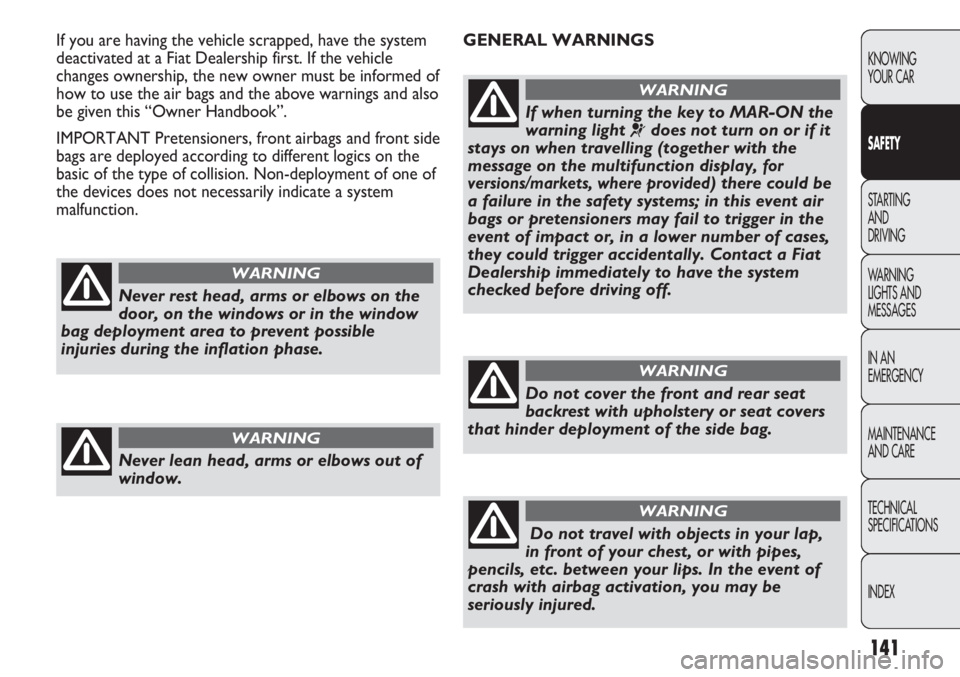
141
KNOWING
YOUR CAR
SAFETY
STARTING
AND
DRIVING
WARNING
LIGHTS AND
MESSAGES
IN AN
EMERGENCY
MAINTENANCE
AND CARE
TECHNICAL
SPECIFICATIONS
INDEX
GENERAL WARNINGS If you are having the vehicle scrapped, have the system
deactivated at a Fiat Dealership first. If the vehicle
changes ownership, the new owner must be informed of
how to use the air bags and the above warnings and also
be given this “Owner Handbook”.
IMPORTANT Pretensioners, front airbags and front side
bags are deployed according to different logics on the
basic of the type of collision. Non-deployment of one of
the devices does not necessarily indicate a system
malfunction.
Never rest head, arms or elbows on the
door, on the windows or in the window
bag deployment area to prevent possible
injuries during the inflation phase.
WARNING
Never lean head, arms or elbows out of
window.
WARNING
If when turning the key to MAR-ON the
warning light
¬does not turn on or if it
stays on when travelling (together with the
message on the multifunction display,
for
versions/markets, where provided
) there could be
a failure in the safety systems; in this event air
bags or pretensioners may fail to trigger in the
event of impact or, in a lower number of cases,
they could trigger accidentally. Contact a Fiat
Dealership immediately to have the system
checked before driving off.
WARNING
Do not cover the front and rear seat
backrest with upholstery or seat covers
that hinder deployment of the side bag.
WARNING
Do not travel with objects in your lap,
in front of your chest, or with pipes,
pencils, etc. between your lips. In the event of
crash with airbag activation, you may be
seriously injured.
WARNING
Page 146 of 287

142
KNOWING
YOUR CAR
SAFETY
STARTING
AND
DRIVING
WARNING
LIGHTS AND
MESSAGES
IN AN
EMERGENCY
MAINTENANCE
AND CARE
TECHNICAL
SPECIFICATIONS
INDEX
With ignition key inserted, on MAR-ON,
even if the engine is off, the air bags can
activate even with the vehicle stopped, if it is hit
by another vehicle. For this reason, children
must never sit on the front seat, even if the
vehicle is not moving. On the other hand,
whenever the key is positioned on STOP,
the safety devices (airbags or pretensioners)
do not deploy after a collision. In this case
non-deployment of these devices does not
indicate a system malfunction.
WARNING
If the vehicle has been subject to theft
or a theft attempt or if it has been
affected by vandalism, flooding or inundation,
have the air bag system checked at a Fiat
Dealership.
WARNING
Turning the ignition key to MAR-ON, the
warning light F(airbag on passenger’s
side enabled) goes on and flashes for a few
seconds, thus reminding the passenger that the
airbag on his/her side will deploy in the event of
a collision. After this time, the light goes off.
WARNING
Do not wash the car seats with water or
pressurised steam (either by hand or at
automatic washing stations).
WARNING
The front airbag is deployed in the event
of collisions with a more severe nature
than those required to activate the
pretensioners. For collisions in the range
between the two activation thresholds, the fact
that only the pretensioners activate is normal.
WARNING
Always drive keeping your hands on the
rim of the steering wheel so that, in the
event of airbag activation, it can inflate without
meeting obstacles. Do not drive with your body
bent forward. Keep the backrest in an upright
position, resting your back on it firmly.
WARNING
Do not hook rigid objects to clothes
hangers or to the support handles.
The air bag does not replace seat belts but
increases their efficiency. Furthermore, since
front air bags are not deployed in low speed
collisions, side collisions, rear-end shunts or roll-
overs, the passengers are only protected by the
seat belts which must be fastened at all times.
WARNING